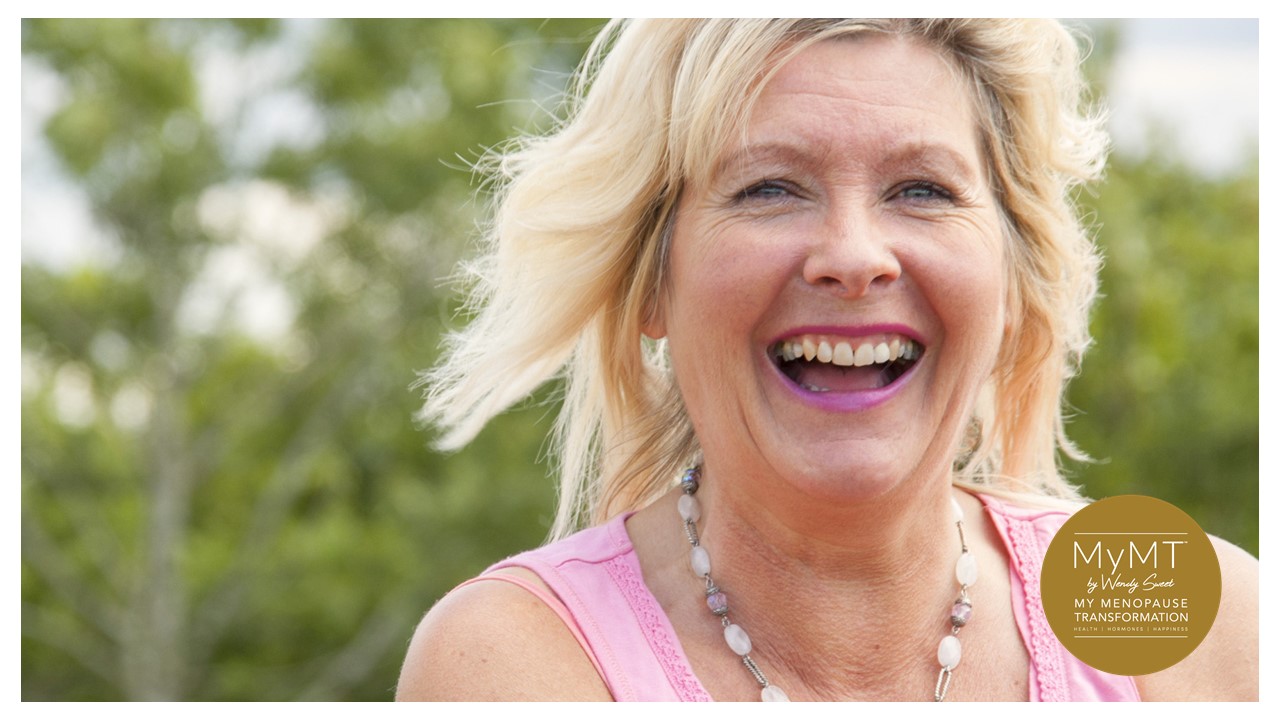Two years ago in early October, I travelled to beautiful Sydney to attend a ‘Happiness’ conference. It was my first time attending this type of conference. But when the day starts with an interview with the Dalai Lama about believing in yourself and ends with a presentation on the neuro-science of happiness, then you know that you are at the right conference when you have a coaching programme that only focuses on women in mid-life. I’ve followed the ‘Happiness’ literature ever since. Steph, who lost her husband and bought up three teenagers on her own, had good reason not to feel very happy. But what she didn’t understand that the stress of her circumstances was a perfect-storm for the changes in her mood and happy-hormones, as she went into peri-menopause. Steph shares her incredible story HERE.
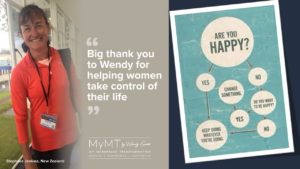
So, are you happy?
If you aren’t, then please don’t beat yourself up about it. As you go into peri-menopause and menopause, just as they did in puberty, our changing mood and motivation hormones cause a bit of chaos with our happiness index. It’s why, when we understand that our menopause transition is a vulnerable time for levels of serotonin and dopamine (our mood hormones), we can put into place strategies that help us to build levels of serotonin naturally. Research shows that fluctuations in oestrogen levels over the lifespan and during ovarian cycles cause predictable changes in serotonin systems in female mammals. Oestrogen and serotonin are inter-related. No kidding! I just wish I’d had this information in my teenage years too.
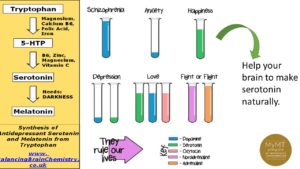
Our changing levels of oestrogen concentrations in menopause are associated with changes that aren’t just ovarian related. I explain this in my online Masterclass on Menopause. Other changes are occurring around our body too. There are physiological changes affecting the central nervous system (CNS), skeletal, vascular, and immune systems (Rybaczyk, Bashaw et al. 2005). It’s no wonder that we can feel a little bit unhappy as we transition into and through menopause when oestrogen receptors and serotonin receptors coexist in cells in such a wide variety of tissues.
As Rabaczyk et al. (2005) state, “Serotonin is usually considered to be a neurotransmitter (nerve-signal transmitter), but surprisingly, only 1% of serotonin in the human body is found in the Central Nervous System. The remaining 99% is found in other tissues, primarily plasma, the gastro-intestinal tract, and immune tissues, where serotonin acts as a hormone and regulates various physiological functions including vasodilation (blood vessel dilation, blood-clotting, recruitment of immune cells, gastro-intestinal motility and initiation of uterine contraction.” [p. 2].
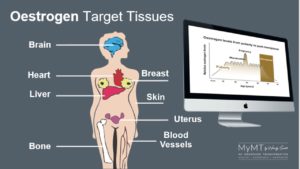
It’s little wonder when oestrogen levels drop, that serotonin follows right behind and our symptoms are so diverse. For example, one of the roles of the serotonin-oestrogen co-existence is to relax smooth muscles in our vascular system (blood vessels), hence, when these hormones decline in menopause, there is an increase in vascular stiffness, which I’ve talked about in other articles to do with our changing cardiac health as we age. This is one of the main reasons that some of you ladies who are doing lots of exercise, may be accumulating more inflammation that you would normally, which in turn results in worsening sleep, depression and of course, reduced recovery time.
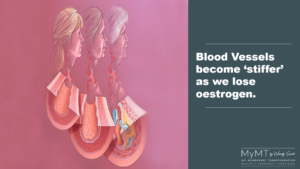
The loss of oestrogen in our menopause transition results in decreased density of certain receptors (5HT2a) that not only help to bind serotonin, but also help to regulate calcium uptake into cells. If some of you are experiencing bloating, fluid retention or muscular cramps, then your calcium balance may be an issue too. Again, many of you who are exercising may not understand that calcium is a known mineral required for your muscles to contract. You need around 1200mg a day, every day. Managing your calcium intake is just one way to help your body adjust to the decline in oestrogen and serotonin production during menopause.
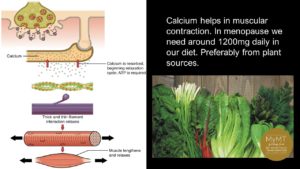
The science of happiness has become a boom-industry and you only need to go to the self-help section of your local bookstore to see what I mean. But much of this advice, although well-meaning, isn’t framed in the context of our menopause transition. As such, our age and stage with our specific hormonal changes get left out of the stories. That’s why scientific studies that make the connection with our changing brain hormones during menopause are important to me. Many of these studies point to specific ways of thinking and acting that can strongly impact our sense of happiness and peace of mind as we arrive in mid-life. But hope, not frustration is the key to improvement so, with many of you being placed on anti-depressants as you arrive in mid-life, I also want to share three of the lifestyle-change strategies that I include in the MyMT™ programmes with you too.
- Help your body to make serotonin by having some tryptophan-rich foods in your daily diet. Research suggests between 3.5-6.0 mg/Kg of tryptophan daily. Some common sources of tryptophan are oats, bananas, dried prunes, milk, tuna fish, cheese, bread, chicken, turkey, peanuts, and chocolate. If you prefer vegetarian sources, then these include seaweed derivatives, spinach, broccoli and other greens. The principal role of tryptophan in the human body is as a constituent of protein synthesis, so beans and starch foods such as beets (beetroot), turnips and sweet potatoes are a great source of tryptophan as well.
2. Turn around your GUT health if you want to absorb tryptophan. It is estimated that 95% of mammalian serotonin is found within the gastrointestinal tract and only 3% of dietary tryptophan is used for serotonin synthesis throughout the body. With gut health changing as we move through menopause, it’s no surprise that sorting out gut health is one of the first steps to improving your mood and motivation (along with sleeping all night of course). Serotonin synthesis is one of the most important tryptophan pathways and tryptophan is absorbed through your GI tract. If your gut health isn’t so great, then please look at my stand-alone module called ‘Restore Your Grateful Gut’ when you get time.
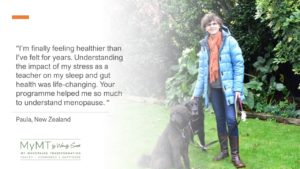
3. Get moving, but don’t over-exercise. If there was one ‘medication’ I would get you all to take for menopause, it would be getting you exercising regularly. I know some of you already do this, but many of you may be too sore (you may need my ‘Restore your Joyful Joints module), too tired or don’t have time to exercise. But there’s another obvious reason too – your serotonin and dopamine levels are also low as you lose oestrogen. These are the hormones that control motivation. Hence, you need to find ways to motivate yourself to do some exercise – use prompts or cues, find a friend to walk with, or buy a bike. If you can’t exercise, because of sore joints, then this is your priority to sort out first. Regular exercise has been associated with improved mental well-being and a lower incidence of depression in numerous studies, including in mid-life women. But many women are doing too much high-intensity exercise as advertised through the fitness industry and not doing low-to-moderate intensity aerobic exercise. This is well evidenced as the best form of exercise for women transitioning through menopause because it helps to alleviate the vascular stiffness that lowering oestrogen and serotonin lead to in our blood vessels as well as help to reduce hot flushes.
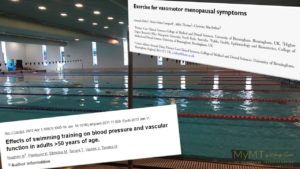
4. As I mention in the next article – Find your ‘flow’. If we are deeply involved in trying to reach a goal, or an activity that is challenging but well suited to our skills, we experience a joyful state called “flow.” Many kinds of activities, such as sports, playing an instrument, reading, studying or knitting, can produce the experience of flow. I talk about this in the next article here in my newsletter. According to Mihaly Csikszentmihalyi, a pioneer of the scientific study of sports psychology and how to find happiness in our everyday life, ‘flow’ is a type of intrinsic (internal) motivation. In his words, “The best moments in our lives are not the passive, receptive, relaxing times… The best moments usually occur if a person’s body or mind is stretched to its limits in a voluntary effort to accomplish something difficult and worthwhile.” ~ Mihaly Csikszentmihalyi (1990, p. 3)
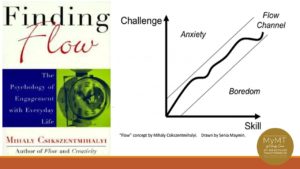
Happiness is a construct that we all have some control over. And yes, I know that it is also a chemical imbalance when it comes to our menopause transition and many of you benefit from the anti-depressants you are prescribed at this stage of life. However, through understanding that menopause (just like puberty, pregnancy and the 6 weeks post-natal) is a particularly vulnerable time of our lives for changing mood-states, we can also put some evidenced lifestyle-change strategies into action to help prevent serotonin levels crashing.
Everything you do from thinking and feeling to taking a walk, is influenced by neurons (nerve cells) in the brain. You have billions of neurons and in order to communicate, neurons depend on neuro-transmitters. These are the chemicals in the brain called serotonin, dopamine and others such as nor-adrenaline (nor-epinephrine). Because these chemicals do more than communicate and have such a powerful effect on mood, then it makes sense that during menopause we have to change our lifestyle to accommodate these changes. That’s why I designed the 12 week MyMT™ programmes specifically for women in their menopause transition. Too many other programmes are not meant for ‘us’ at this life stage. When you have time, please have a listen to the video below, or share it with a friend. What I have to say just might resonate with you too.
References:
Richard, D., Dawes, M., Mathias, C., Acheson, A., Hill-Kapturczak, N., & Dougherty, D. (2009). L-Tryptophan: Basic Metabolic Functions, Behavioral Research and Therapeutic Indications. International journal of tryptophan research : IJTR, 2, 45–60. https://doi.org/10.4137/ijtr.s2129
Tanaka H., Dinenno F., Monahan K., Clevenger C., DeSouza C., Seals D. (2000). Aging, habitual exercise, and dynamic arterial compliance. Circulation. 12, 102(11):1270-5. doi: 10.1161/01.cir.102.11.1270. PMID: 10982542.
Tanaka, H. (2019). Antiaging Effects of Aerobic Exercise on Systemic Arteries. Hypertension. 74:237–243
Villaverde G., Torres L., Ábalos, G., Argente del Castillo M., Guisado I., Guisado B., Ramírez R. (2012). Influence of exercise on mood in postmenopausal women. J. Clin Nursing, 21(7-8):923-8. doi: 10.1111/j.1365-2702.2011.03972.x. PMID: 22409782.
